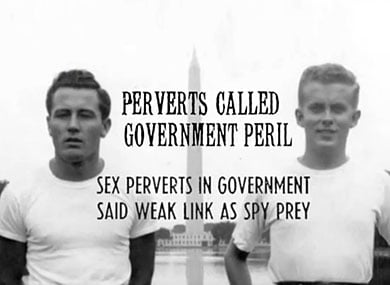
Interrogations of one’s sexuality became commonplace in the 1950s and 1960s’ federal workplace. Questions like “Do you identify as a homosexual or have you ever had same-sex sexual relations?” were commonplace as employers attempted to root out LGBT employees. This period of time is often known as the Lavender Scare—the interrogation and firing of LGBT-identifying civil servants.
Before the Lavender Scare and post-World War II, LGBT individuals from rural towns began congregating to cities where they could keep anonymity. This newfound peace and community, however, was disturbed in 1947 when the United States Park Police created a Sex Perversion Elimination Act. Primarily targeting these communities in parks, at least five hundred people were arrested and 76 were charged.
As a part of the broader Red Scare that targeted communists, the Lavender Scare’s development was in large fault due to Senator McCarthy, who brought to the Senate his famous list which gave the names of two hundred and five federal employees, two of which were homosexual individuals. While federal agents began to investigate Senator McCarthy’s federal employment list, much of the Red Scare rhetoric also invoked the ideas of morality connected with queer and homosexual people to those of communists. At the time, homosexuals were viewed as sinful and perverted and the public perception of homosexuality shared many similarities with the public view of communists, who were similarly viewed lacking in both moral and mental strength. For the federal government, LGBT employees began to pose a security risk: if they were living double lives, then they may not be loyal nor mentally stable enough to keep government secrets.
Eventually, Senators Wherry and Hill, who were supported by McCarty, interrogated the two LGBT individuals on McCarty’s list, leading to their discharge. In March 1952, the federal government announced its removal of 162 civil servants suspecting of being homosexual. And about a year later on April 27, 1953, President Dwight Eisenhower signed Executive Order 10450, expanding on Truman’s federal employment regulations with a statement to exclude federal employees of “sexual perversion.” Because of this Executive Order, it is estimated that at least ten thousand civil servants lost their jobs.
The Lavender Scare made being publicly LGBT difficult. Although homosexuals were largely closeted before the Lavender Scare, being publicly LGBT during the 1950s was largely challenging and near impossible without staggeringly high consequences. Not only were LGBT federal employees fired, but many others were also simply fired for “guilt of association” in knowing someone who was LGBT. Because of the resulting stigma within federal government as well as in larger public culture, many of the federal investigations and resulting firings lead to dismissed employees’ suicides — most of which were later covered up by the federal interrogators.
Several LGBT people later stepped up to challenge federal government’s “sexual perversion” components, including civil servant Frank Kameny who took his case to the Supreme Court. Although Kameny lost, a few federal courts began ruling in his favor by 1969. More gay rights organizations also developed such as the Mattachine Society (1950) as well as the Daughters of Bilitis (1955). The Lavender Scare’s effects, however, were still lasting.
The Lavender Scare not only broke up and quieted the cities’ queer communities who were afraid of federal employment discrimination and potential hate crime, but it also resulted in a largely conservative, homogenous culture within the government. While most federal organizations overturned their policies on LGBT discrimination, the Federal Bureau of Investigation (FBI) and National Security Alliance (NSA)’s bans on homosexuals lasted into the 1990s, until they were officially overturned by President Bill Clinton in 1995. Later, as recent as 2015, Secretary of State John Kerry apologized to the LGBT community on behalf of the federal government’s Lavender Scare interrogations, stating: “I apologize to those who were impacted by the practices of the past and reaffirm the department’s steadfast commitment to diversity and inclusion for all our employees, including members of the LGBTI community.”
This post is part of a series of posts highlighting LGBT history in the workplace and in the government in celebration of LGBT History Month 2017.
